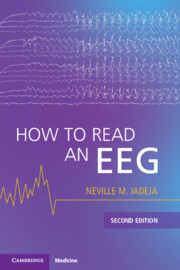Book contents
- How to Read an EEG
- Reviews
- How to Read an EEG
- Copyright page
- Dedication
- Contents
- Figure Contributions
- Foreword to the First Edition
- Preface
- How to Read This Book
- Part I Basics
- Part II Interpretation
- Part III Specific Conditions
- Chapter 15 Seizure Mimics
- Chapter 16 Types of Seizures
- Chapter 17 Epilepsy
- Chapter 18 Epilepsy Syndromes
- Chapter 19 Lesions and Encephalopathy
- Chapter 20 Status Epilepticus
- Chapter 21 Postcardiac Arrest
- Appendix: How to Write a Report
- Index
- References
Chapter 19 - Lesions and Encephalopathy
from Part III - Specific Conditions
Published online by Cambridge University Press: 27 September 2025
- How to Read an EEG
- Reviews
- How to Read an EEG
- Copyright page
- Dedication
- Contents
- Figure Contributions
- Foreword to the First Edition
- Preface
- How to Read This Book
- Part I Basics
- Part II Interpretation
- Part III Specific Conditions
- Chapter 15 Seizure Mimics
- Chapter 16 Types of Seizures
- Chapter 17 Epilepsy
- Chapter 18 Epilepsy Syndromes
- Chapter 19 Lesions and Encephalopathy
- Chapter 20 Status Epilepticus
- Chapter 21 Postcardiac Arrest
- Appendix: How to Write a Report
- Index
- References
Summary
This chapter focuses on EEG findings with lesions (focal cortical dysfunction) and encephalopathy (global cortical dysfunction). The EEG is not as sensitive or specific to detect lesions compared to neuroimaging but is useful in determining their functional consequences especially seizure risk. Focal monomorphic rhythmic slowing (e.g., lateralized rhythmic delta activity) has an increased risk of epileptic seizures like other epileptiform abnormalities including periodic discharges. The EEG is highly sensitive though not specific for the diagnosis of global cortical dysfunction (encephalopathy) and may be used to estimate its severity and identify repetitive patterns that may be associated with nonconvulsive status epilepticus (NCSE). Encephalopathy is characterized by slowing of the electrographic background, decrease in voltage, and loss of reactivity/variability. Occasionally, EEG findings may also be suggestive of uncommon etiologies such as Creutzfeldt– Jakob disease or anti-NMDAR encephalitis. [133 words/853 characters]
Keywords
Information
- Type
- Chapter
- Information
- How to Read an EEG , pp. 284 - 303Publisher: Cambridge University PressPrint publication year: 2025
References
Accessibility standard: WCAG 2.2 AAA
Why this information is here
This section outlines the accessibility features of this content - including support for screen readers, full keyboard navigation and high-contrast display options. This may not be relevant for you.Accessibility Information
Content Navigation
Allows you to navigate directly to chapters, sections, or non‐text items through a linked table of contents, reducing the need for extensive scrolling.
Provides an interactive index, letting you go straight to where a term or subject appears in the text without manual searching.
Reading Order & Textual Equivalents
You will encounter all content (including footnotes, captions, etc.) in a clear, sequential flow, making it easier to follow with assistive tools like screen readers.
You get concise descriptions (for images, charts, or media clips), ensuring you do not miss crucial information when visual or audio elements are not accessible.
You get more than just short alt text: you have comprehensive text equivalents, transcripts, captions, or audio descriptions for substantial non‐text content, which is especially helpful for complex visuals or multimedia.
Visual Accessibility
You will still understand key ideas or prompts without relying solely on colour, which is especially helpful if you have colour vision deficiencies.
You benefit from high‐contrast text, which improves legibility if you have low vision or if you are reading in less‐than‐ideal lighting conditions.
